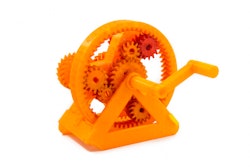
The inability to perfectly correlate demand with supply has been a key riddle for supply chains and logistics throughout history. Too much product is a glut. Too little is a scarcity.
Striking a balance is hard, so suppliers use sophisticated algorithms to take their best shot at how much of their products will be needed at a certain time and a certain place to meet an uncertain demand. Couple that with the need to produce products in large quantities to achieve economies of scale and the issue is exacerbated.
To deal with this, suppliers produce products in large quantities in low labor cost countries, ship and store those products near their customers, hoping that their demand projections turn out to be accurate. This projection is always imperfect, especially considering that the value of inventory in the United States alone was $1.8 trillion in 2015, according to the U.S. Department of Commerce. Assuming an inventory carrying cost of 25 percent, that’s $450 million U.S. companies pay each year to hold that inventory.
What if you could flip the supply-demand equation on its head? Instead of producing in anticipation of demand, what if you could produce on demand, after the customer has committed to buy the product? How much inventory could you reduce? How much could you improve your cash flow and reduce overhead? How much unnecessary material, production, storage and transportation could be eliminated? How much better could you serve your customer by producing exactly what they want when they want it and where they want it?
This is the promise of additive manufacturing, more commonly known as 3D printing.
Making Strides
Unfortunately, we’re not that close to reaching this nirvana, but we are making strides. A good example is what Adidas and technology-provider Carbon are doing with the new FUTURECRAFT athletic shoes. Next year, they will introduce an athletic shoe that is custom fit to each foot, as well as the customer’s weight, gait and sport. The consumer’s foot will be scanned and then custom shoes will be made and delivered directly to their door.
It’s a move that thrills everyone from industry watchers to sneaker enthusiasts. It is likely that 10 years from now, kids will look back in amazement that we ever settled for “best fit” shoes that weren’t personal. This will extend beyond shoes to everything from eyeglasses to artificial knees.
With additive manufacturing, there is no cost for complexity. Printing a 5-inch by 5-inch solid block of material will actually be more expensive than a 5-inch by 5-inch highly complex design because it uses more material. By the way, that design may not have even been possible to make any other way. Consider the additively manufactured GE fuel nozzle for their new Leap aircraft engine. It used to be made out of 20 separate parts that needed to be assembled, now it’s one print that is lower weight, more efficient and more durable.
The Golden Age
At this point you may be thinking, “Is this the end of the supply chain industry?” Absolutely not. This actually may be the beginning of a golden age for supply chain. Think of additive manufacturing as another tool in the toolbox to improve supply-chain efficiency. Much thought is being given to how this will bring production—and likely jobs—closer to demand centers. Dusty old warehouses will be reinvigorated and reimagined as thriving hubs for smaller batches of needed products.
The possibilities are exciting. When a piece of equipment, like an MRI machine or server goes down, there is typically a service agreement in place for a technician to get that important machinery back up and running in short order. To do this, sellers have to store parts near their installed base. A tiny fix may be needed, but if that part isn’t nearby, waiting a few days for shipping can lead to big problems for a company. Airlines, for example, count delays in seconds. The quicker a plane is fixed, the quicker it gets in the air.
As a result, UPS has a network of more than 1,000 locations around the world where parts are stored close to the point of need for quick access. They know, because the inventory is in their facility, that much of it turns very slowly—or not at all. That doesn’t always make good business sense, but the tide is turning as additive manufacturing cost and speed have been improving at an exponential rate. It may only make business sense to store 5 to 10 percent of your product in “virtual inventory” to print on-demand today, but as material and printer technology continues to improve exponentially, UPS expects that percentage to go up rapidly.
Another bonus? Less waste will be created, which in turn helps the environment.
Consider an electronics company that wants to create custom earbuds that fit each of their customer’s ears perfectly. Once the digital file of each ear is created from a smartphone picture and the custom 3D printing earbuds are manufactured, it still has to be assembled to the standard devices that make the sound come to life. If that manufacturing, assembling, packing and shipping all occurs in one location, is it a manufacturing solution or a logistics solution?
The key point is that this is not an either/or situation between the traditional manufacturing supply chain and additive manufacturing. An analogy might be the microwave oven that was supposed to revolutionize the kitchen. While most homes do have microwave ovens, they also still have stoves and ovens. I’m not ready to cook my Thanksgiving turkey in the microwave. It’s about using the right tool in the right situation. This is where logistics professionals thrive.



















